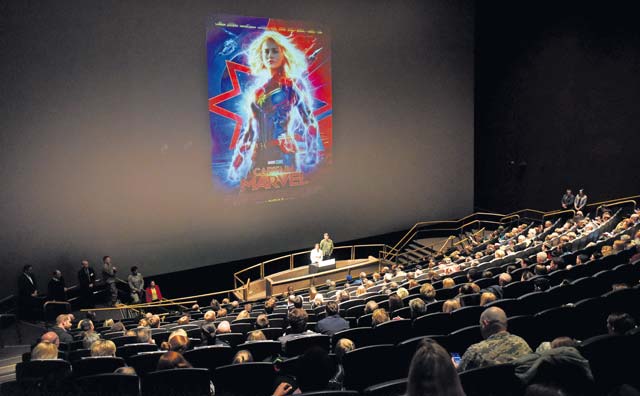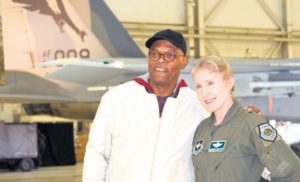
Less than one percent of the American population will know what it’s like to serve in the Air Force. However, major motion pictures give the global audience a glimpse into the service’s history of breaking barriers and a taste of its fighting spirit.
To ensure an accurate depiction of military service, filmmakers and actors immersed with Airmen from across the Air Force during the filming of “Captain Marvel,” starring Brie Larson as Carol Danvers.

Larson’s character is a young Air Force pilot in the late 1980s. After graduating from the U.S. Air Force Academy, she excels in pilot training, flies the F-15 Eagle and moves quickly to the world of test flight. A flight test incident leaves Carol infused with extraordinary powers.
“When I graduated from the Air Force Academy in 1982, there were about 150 women pilots in the United States Air Force, and none of them were fighter pilots because it was actually against the law for women to fly fighters,” said Secretary of the Air Force Heather Wilson during the showcase of “Captain Marvel” at the Smithsonian National Air and Space Museum in Washington, D.C., March 7. “Today, we have 850 women flying for the United States Air Force and the defense of this country, and about 80 of them are fighter pilots. I’ve talked to Airmen who have helped with the technical assistance on this film and they were pleased that the co-directors had really captured what it means to be an American Airman … that ethos of going higher, further, faster,” she added.
Airmen partnered with Marvel Entertainment through the Air Force Public Affairs Entertainment Liaison office, which offered direct access to resources including personnel, aircraft and equipment, technical assistance and military advice and locations. This ensured the portrayal of the Airmen and missions were plausible and realistic.
“Our mission is to project and protect the image of the U.S. Air Force through entertainment media,” said Lt. Col. Nathan Broshear, Air Force Entertainment Liaison Office director. “Major motion pictures, like ‘Captain Marvel,’ provide an incredible platform to educate and inform the American public about the people, culture and heritage of the U.S. Air Force … inspiring the next generation of Airmen.”
Ryan Fleck, who co-directed the movie with Anna Boden, expressed his appreciation for every Airman’s professionalism and respect.
“Everyone we met in the Air Force was so selfless and giving to our process, and I was really impressed,” he said. “We couldn’t necessarily figure out what an intergalactic space warrior was up to, but we could come to the Air Force and see what it was like to be a pilot. Every detail, every phase of the process was huge, not only for us in the writing, but for Brie as well when she is playing the character … from how she held her helmet to how she walks.”
Additionally, materials collected from Airman Magazine Archives and consultations with Air Force Materiel Command, Edwards Air Force Base, California, and U.S. Air Force Academy historians resulted in period-correct 80s and 90s hardware, uniforms and details.
The Air Force’s involvement also impacted character development and storylines. In December 2017, Larson, Boden, Fleck and producer Jonathan Schwartz visited Nellis AFB, Nevada, and spent one-on-one time with Brig. Gen. Jeannie Leavitt, Air Force Recruiting Service Commander and the Air Force’s first female fighter pilot.
“We put Brie Larson in the backseat of an F-16 (Fighting Falcon) so she could experience being in a high performance fighter aircraft firsthand. I think that helped her understand what it was like,” said Leavitt. “I appreciated the fact that they wanted to get the characters to be an accurate portrayal of a female fighter pilot in the Air Force.”
Continuing cooperation between the Air Force and Hollywood has resulted in support of hundreds of films and television programs to include “Sully,” “Bridge of Spies,” “Man of Steel,” “Godzilla,” “Lone Survivor” and multiple “Transformers” and “Iron Man” films.
“It’s important to know these partnerships are conducted at no cost to the taxpayer — studios reimburse bases for any expenses incurred as a part of the military unit’s participation in selected projects — but our investment of time and energy provides an incredible return on investment for all involved,” Broshear said. “Airmen are able to be a part of cinematic history, ensuring audiences see an accurate portrayal of lives dedicated to excellence, integrity and service before self.”


